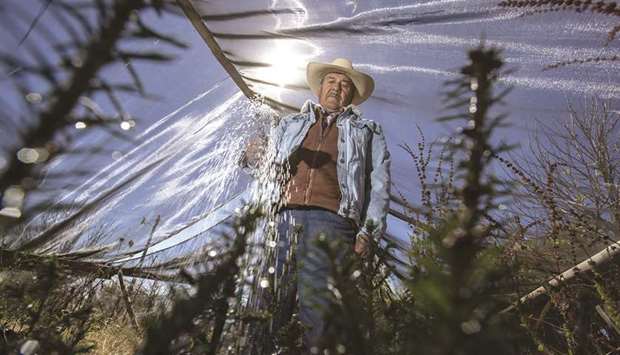As a boy, Francisco Ramirez Cruz loved hiking with his grandfather up into the mountains of central Mexico. While the old man grazed sheep or hunted for wild mushrooms, Ramirez would play amid the throngs of monarch butterflies that migrated 3,000 miles to this forest each autumn, turning the blue sky into a sea of orange.
Ramirez is 75 now, himself a great-grandfather, and each winter he still goes looking for butterflies. But these days, he might spend hours searching the forest without catching sight of a single one.
The world is losing monarch butterflies at a startling rate, as logging, herbicides and other human activities destroy natural habitats. But the biggest threat yet has only recently come into focus. Climate change, with its extreme storms, prolonged droughts and warming temperatures, is poised to eradicate the forest that serves as the butterfly’s winter refuge.
In the last two decades, the population of monarchs overwintering in Mexico has declined from an estimated 1 billion to fewer than 100 million. If they go extinct, it would mark the loss of one of the world’s few migratory insects. In the United States, conservationists have petitioned to have the monarch protected under the Endangered Species Act; a ruling is expected this year.
To help his beloved butterflies, Ramirez has partnered with scientists on a monumental experiment: They are trying to move an entire forest 1,000 feet up a mountain.
On one of the scientists’ early scouting trips to the region several years ago, locals suggested they meet Ramirez, a respected farmer with graying sideburns and a thin moustache who lives on a windswept hillside in Ejido La Mesa, a community that overlaps with the Monarch Butterfly Biosphere Reserve — a national park 70 miles west of Mexico City.
Known by the honorific “Don Pancho,” Ramirez is a former elected leader of La Mesa and is hailed as a hero for helping to bring electricity to the area in the late 1980s. Most importantly, he knows the forest intimately, thanks to the time he spent there, starting in the 1950s.
Ramirez has seen the effects of climate change firsthand — parched fields in the winter, violent thunderstorms in the summer — and felt a calling to protect the butterflies, whose annual arrival and departure have long helped the community mark the passage of time.
Each fall, when the butterflies arrive as if by magic from Canada and the eastern United States, gliding by the millions down over the rolling hills of La Mesa, locals stop what they are doing and look up to admire them. They do the same each spring, when the butterflies depart.
“In the early days, we didn’t know where they came from,” said Ramirez, who talks the way he moves — slowly and deliberately. “But we have always been so happy to see them.”
He believes that protecting the butterfly and its habitat will also help protect his pueblo, which depends on timber from the forest and the tourists that flock to the region to see the monarchs.
He agrees with Cuauhtemoc Saenz-Romero, a forest geneticist who has hired Ramirez to help with the project, that it is necessary to create an ecosystem where the butterflies will be able to survive.
“It’s an idea that may sound radical,” said Saenz-Romero. “But by the end of the century it may be absolutely needed.”
The butterflies that winter here, known as eastern monarchs, seek sanctuary in the oyamel firs that tower in and around the reserve.
The trees, known as “sacred firs” because their conical shape calls to mind hands clasped in prayer, offer a dense canopy that acts as an umbrella for the butterflies that cluster by the thousands on their trunks and branches. The oyamel protects the butterflies from chilly winter rains and creates a microclimate cold enough to keep the butterflies in a state of hibernation but not so frosty as to kill them.
Scientists fear that climate change may kill off these firs altogether. A 2012 research paper co-authored by Saenz-Romero and published in the journal Forest Ecology and Management found that the area suitable for the oyamel is likely to diminish by 96 percent by 2090, and disappear completely within the reserve.
The region is warming at such an accelerated pace that the trees won’t be able to adapt, scientists say, and will need help migrating to areas where the climate is predicted to be suitable for them in future years.
Over the last several years, the team of researchers has overseen the relocation of about 1,000 fir saplings that were growing at lower altitudes up to higher — and cooler — elevations.
“We have to assist them,” said Saenz-Romero, a professor at the Michoacan University of St. Nicholas of Hidalgo. “They cannot do this themselves.”
Ramirez and the scientists have become fast friends. When he helped them search for the right location to plant the first round of saplings, he insisted that the researchers stay on his farm, which offers modest accommodations (the toilet is flushed with a bucket) but heart-stopping vistas of snow-covered peaks.
In the middle of Ramirez’s orchard of apple and plum trees, the scientists helped him construct a small greenhouse, where he tends to several dozen saplings that were taken from the forest and will eventually be replanted.
On a recent blustery morning, he watered the trees with a hose while listening to the sentimental ranchera songs drifting from the house of a nearby neighbour. Then he slowly folded himself into the passenger seat of Saenz-Romero’s silver pickup truck, and they headed up the mountain to check on the trees that had already been planted.
They made an unlikely pair — the farmer in a straw cowboy hat and the city-dwelling scientist in a jaunty black beret — but on the 45-minute drive on a rutted dirt road, Ramirez and Saenz-Romero made easy conversation. They talked about a mudslide years earlier that had killed several people and taken down many fir trees, and they discussed the rain (there hadn’t been any recently).
At one point, Ramirez gestured with a roughened hand toward a vast pine tree at a bend in the road; he remembered it from his youth. Saenz-Romero slowed the car and they paused to admire it.
Up the mountain, they parked and hiked a few minutes to the first of two planting sites, a clearing that had been created by a forest fire three decades before. Rows of small trees were growing, each marked by a pink plastic spoon stuck in the dirt. In the 3 ½ years since the scientists hired locals to help plant these saplings, the trees have grown from 7 inches to a stately 4 feet.
As Ramirez showed off the plants, he grinned proudly.
“Beautiful,” he said.
Ramirez and the scientists are learning what the trees need to survive. They have found, for example, that trees are more likely to live if planted under the shade of nearby “nurse” plants. They hope to expand the project and establish the trees at even higher altitudes on other nearby mountains — seeding ecosystems now that monarchs could potentially use later if temperatures continue to rise.
So-called assisted migration is happening in other parts of the world, including Canada, where commercial forestry operations have begun replacing dead lodgepole pines with a species of larch that grows at lower and drier elevations. Plant moving is controversial among some scientists, who warn of unintended consequences when humans intervene in nature’s course, but it is increasingly seen as a needed response to a rapidly changing climate.
“There’s no doubt that things are going to change,” said Chip Taylor, a retired ecology professor in Kansas and the director of Monarch Watch, which runs a butterfly tagging program. The experiment in Mexico, if successful, is a short-term solution, he said. But it’s an important one.
“What these measures do is give us time to address climate change,” he said. “If we don’t do something eventually about CO2s, eventually the new trees will be pushed off the mountain too.”
La Mesa and the surrounding areas haven’t contributed many of the greenhouse gases that are transforming the climate. In fact, in many ways the region feels stuck in a previous century, with dusty burros that trudge up the pocked two-lane highway, firewood piled on their backs, and shepherds reclining in green pastures, one eye on their flocks. Ramirez’s wife, Petra, whom he met half a century ago at a Day of the Dead celebration in a nearby town, still cooks her chicken mole in a pan over an open fire.
But La Mesa is clearly suffering the effects of an altered climate.
When Ramirez was growing up, it used to rain from June to November. Now the rains arrive in July and end in October. Not only is the wet season shorter, but it is also more brutal; the drier season is even more dry.
Over the last couple of decades, the area’s agriculture industry suffered, partly because of warming and partly because of competition brought about by the North American Free Trade Agreement. Family-run corn and potato farms, which used to blanket the hillsides, couldn’t compete with US agribusiness. Ramirez stopped planting corn because it became cheaper to buy it. For many years, he lived in Mexico City and worked in construction.
As jobs dried up, many locals had to migrate, just like the monarchs do. That included two of Ramirez’s sons, who toiled for a time in the United States, and several other family members who still live there. In a small chapel his father built on the farm, Ramirez and his wife keep fresh flowers and a framed picture of Toribio Romo Gonzalez, a Catholic saint known as a protector of immigrants.
The money sent back from north of the border has funded construction of opulent — if architecturally discordant — homes in La Mesa, their archways and turrets standing out amid the typical adobe and concrete shacks. – Los Angeles Times/TNS

COMMITTED: Francisco Ramirez Cruz waters Oyamel fir saplings maturing in a greenhouse on his family’s ranch in La Mesa, Estado de Mexico.

